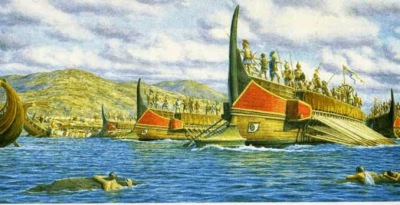Naval battle whereby Athens lost the Peloponnesian War. In the summer of 405 b.c., Lysander, the de facto Spartan commander (nominally he was second in command), brought the Peloponnesian fleet into the Hellespont (Dardanelles) and took the city of Lampsacus (Lâpseki). The Athenian fleet of 180 triremes took up a position on the European shore at Aegospotami, about three nautical miles away, and sought to engage Lysander in a naval battle. When he repeatedly refused, the Athenians found themselves in a predicament because of the lack of provisions at Aegospotami. Alcibiades, now in exile, visited the Athenian camp and recommended moving the fleet to Sestos, 10 nautical miles to the southwest, where supplies were available, but both he and his advice were coldly received. The Athenian generals were afraid to let Lysander out of their sight, lest he intercept the grain ships coming from the Black Sea or induce additional cities to revolt against the Athenian Empire.
According to Xenophon, the Athenians tried for five successive days to engage Lysander in battle; each day Lysander stayed in the harbor but sent ships to spy on the Athenians. On the fifth day, after the Athenians had returned to Aegospotami and were foraging for food, Lysander attacked unexpectedly and caught the Athenians off guard, capturing almost all of their ships on the beach, except for nine triremes: the state trireme, the Paralus, which brought news of the disaster to Athens, and eight triremes under Conon, who was one of the generals and who sailed to Evagoras, king of Salamis on Cyprus.
In Xenophon’s version, there was hardly a battle, but other contemporary sources characterize it as one. According to Diodorus Siculus, whose account is indirectly based on a lost contemporary source (the Hellenica Oxyrhynchia), Lysander attacked when the Athenian fleet, led by the general Philocles, began to relocate (presumably to Sestos). Diodorus’s version has 10 Athenian triremes escaping, one of which Conon took to Cyprus. Scholarly opinion is divided on the merits of Xenophon’s and Diodorus’s different accounts of events. Both say that Philocles was captured and executed. Xenophon implies that all the Athenians taken prisoner were executed; two late sources put the number killed at 3,000 or 4,000 men. Suspicions in Athens that one or more of the Athenian generals had betrayed the fleet are understandable but probably unfounded.
In any case, very few of the Athenian triremes made it home, and the Athenians had no means to build a new fleet. Besieged by land and sea and unable to import food, the Athenians finally came to terms in March 404 b.c., ending the Peloponnesian War.
Pausanias’s Description of Greece describes the monument at Delphi commemorating the battle and names the allied commanders who shared in the victory.
